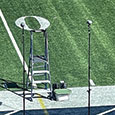
Designing a marching band show can be an intimidating adventure. Novice drill designers often turn immediately to computer-aided drill design software, but computer programs are only capable of working with and manipulating information received. To function effectively as a designer, first take steps to gather as much informations as possible, then turn to the computer. Following these steps will ensure a show that follows a cohesive logical progression, aided by clearly designated visual and musical climactic moments.
Listen
It is important to listen to the music and begin imagining different movements, shapes, and forms that support the music. Keep a list of descriptive terms, which will eventually determine movement and forms. For example, music described as hard and driving will best fit angular forms. A lyrical and flowing mood will result in soft and open forms. Occasionally I hear a section that inspires something specific and I immediately sketch something out on paper.
Avoid thinking only in terms of pictures or sets when listening. It is also important to consider what kind of movement might best fit the music. Motion and movement are the glue between sets and often play a big part in determining how the picture on the field comes across. It is not just a matter of going from point A to point B. From the perception of movement in a stationary form to actual movement such as follow the leader, expansion or contraction, motion is key.
The listening phase is open-ended. I usually keep the music in my car or listen in my free time. The longer I listen, more of the answers fill in, although time quickly becomes scarce when writing a new show each week.
Sketch
Based on the findings from listening, begin writing down types of movement and sketching shapes and possible forms that allow this movement. Time spent sketching can range from an idea that pops to mind at dinner and is written on a napkin to being precise and focused, where I sit down specifically to sketch. When writing drill, I am extremely aware of shapes. I remember driving to work one morning and noticing the shape of the street lights for the first time. Inspiration of what to sketch comes from many sources, including the curvature or angle of a logo or the softness of clouds.
These sketches create a point of departure when charting and designing begin, and a simple sketch frequently leads to a completely different idea. Sketches bring clarity to the boundaries and space the designer has to work. A sketch idea may work for the entire band, or it may need to be augmented with other shapes. With the curve of the street lamp, it might only work for the brass up front, in which case I could frame it in back with some of the woodwinds. It depends on the music and the size of the ensemble.
The beautiful thing about sketches is that they can be recycled. What is unused one week will almost certainly work at some point in the future. Each drill designer has a toolbox of tricks to which he keeps returning.
Analyze
The next step is to compile a phrase and structural analysis of the musical chart. This information is entered into a count-segment table (pdf) that will eventually be the blueprint when the time comes to start designing. Data compiled thus far from the listening and sketching stages should also be entered. Important information such as type of movement and motion, designated climax, and useful descriptive adjectives to describe musical phrases is added.
The designer may also choose to include staging and integration information for the drum line, color guard, dance team, and majorettes. The final product will be a detailed and descriptive table that keeps track of counts, musical segments, staging, transitions, and other pertinent design and staging information needed during the design process. The table can include as much information as a designer might wish to have.
Know the Flow
An energy chart can be another useful tool. This chart is like a line graph, showing direction of musical energy, up or down, for each individual musical selection, and for the show as a whole. Within the overall framework of the story, individual peaks and valleys occur to avoid stasis. The most visually and musically compelling aspect of the show will be the highest point of the graph. Other climactic moments may occur, however, these sets must be secondary to the most compelling moment of the show. Knowing the high point of the show is important; everything is either leading to or a consequence of that moment. It helps to build the storyline by knowing what the show is progressing toward.
Begin Charting
After all the information has been collected, the designer must accurately size forms through charting. This is where a computer program comes into play. Computer programs only work with the information they receive, so designers who have already been creative and done their research can now pluck ideas, no matter how rough the may be, into the program and play with the form to see if it will work with the available instrumentation. Rarely does the rough size of a form fit exactly to the number of marchers, so experimentation with form and spacing is necessary. Do not worry if a sketch must be discarded; it may work for next season’s show.
The decision about whether to use a consistent distance of spacing or an adjusted interval will have to be made at this point. The advantage of a consistent interval between marchers is that students are used to one interval throughout the entire show. A benefit to variable spacing is that it allows for more creativity in design.
Design
At this point in the process the count-segment form table, flow chart, and information from charting, will guide design decisions. The designer has many puzzle pieces at his disposal to create the final product that will be the show. What occurs visually is driven by what happens musically. The two exist in a symbiotic manner.
This is the point at which a novice designer may revert to thinking in terms of pictures or hard sets, instead of movement and motion. The designer should consider movement and motion first, and the resulting set from that movement second. A majority of what is seen in a show is the motion between sets; the set is a byproduct of the movement that is called for and often serves a utilitarian rather than aesthetic purpose.
It is ineffective for a designer to start on page one and move straight through the show. Unfortu-nately, drill design software makes this mistake very easy. Often starting on page one can lead a drill designer to write into a corner. This does not allow the show to progress with cohesion and proper flow, and will result in a series of random pictures.
The first form and page designed should be the most musically and visually compelling moment of the entire show. Next to be designed are the climaxes of each tune. Once climaxes have been designed, continue to tell the story by designing connective sets that serve as glue between climaxes. With some programs a show can be written backwards, but there can be so much distance between the beginning of the show and the climactic point that this feature is not always the most helpful.
When I first started writing for my university marching band, it took roughly 40 hours to finish a show. Over time I became more efficient, but even now I stick with this process, and I can get a show taken care of in 5-10 hours. Any director is capable of designing a show, as long as a careful and thoughtful, step-by-step process is followed. Countless opportunities and decisions exist in the initial planning stages, and trusting and investing in this six-step process will allow even novice drill designers to create musically and visually compelling shows.






